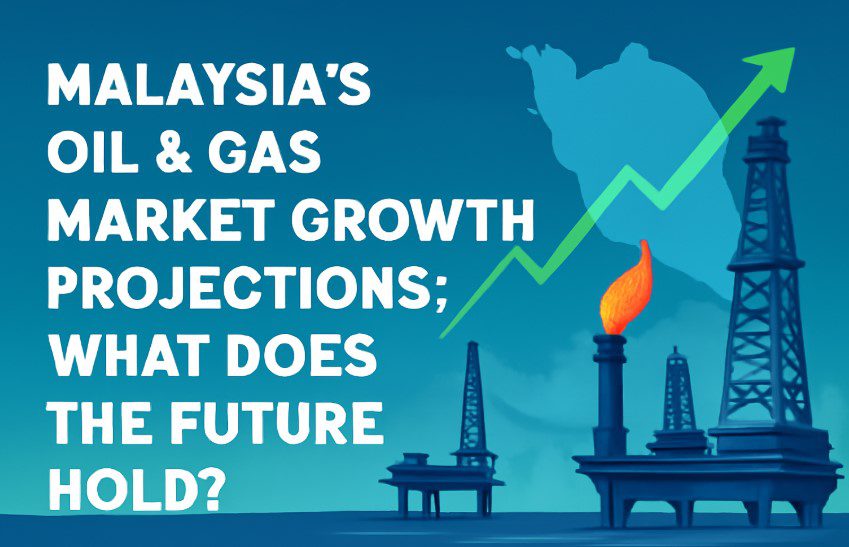Malaysia's Oil and Gas Market Growth Projections: What Does the Future Hold?

The oil and gas industry is one of Malaysia’s most crucial sectors, contributing significantly to the nation’s economy. With a long history of oil and gas exploration, Malaysia remains a key player in Southeast Asia’s energy market.
As we look towards the future, market analysts predict steady growth for the industry through 2030, driven by strategic investments, technological advancements, and increased global demand for energy.
In this article, we’ll explore the key factors behind Malaysia’s oil and gas market growth projections and what the future holds for businesses, investors, and industry professionals.
What’s Driving Malaysia’s Oil and Gas Market Growth?
According to recent market projections, Malaysia’s oil and gas market is expected to grow at a compound annual growth rate (CAGR) of 1.4% by 2030, reaching an estimated 738.48 thousand barrels per day. Several key factors are contributing to this projected growth:
1. Increased Demand for Refined Petroleum Products
As the global demand for oil and gas products continues to rise, especially in emerging markets across Asia, Malaysia stands to benefit. The growing demand for refined petroleum products, such as gasoline, diesel, and jet fuel, is set to drive growth in Malaysia’s refining sector.
2. Technological Advancements
Innovation is a critical enabler of growth in the oil and gas industry. From automated drilling rigs to data analytics and AI-driven exploration, Malaysia’s oil and gas companies are embracing new technologies to boost efficiency, optimize production, and reduce costs. This technology adoption is helping to make the sector more competitive and sustainable.
3. Strategic Investments and Partnerships
Malaysia’s oil and gas sector is seeing increased investments from both local and foreign companies. Major players like PETRONAS are expanding their exploration and production activities, and joint ventures with international energy firms are accelerating the development of new offshore fields. These investments help secure Malaysia’s position as a leading energy hub in Southeast Asia.
4. Government Support and Policy Initiatives
The Malaysian government has implemented policies that support the oil and gas sector’s growth, including favorable taxation regimes, incentives for research and development, and initiatives for sustainable energy practices. These policies create a conducive environment for growth and attract foreign investments.
5. Expanding Global Market Reach
Malaysia’s oil and gas exports, particularly liquefied natural gas (LNG), are seeing rising demand in markets like China, Japan, and South Korea. As these markets continue to expand, Malaysia’s oil and gas sector is poised to capitalize on the increasing need for energy resources globally.
What Does the Future Hold for Malaysia’s Oil and Gas Industry?
As we look to the future, Malaysia’s oil and gas market is expected to evolve significantly over the next decade. Here are some trends to watch:
1. Focus on Sustainable Practices
As global attention shifts to environmental concerns, Malaysia is making strides in incorporating sustainability into its oil and gas operations. Carbon capture and storage (CCS) technology is being increasingly adopted to mitigate CO₂ emissions. Malaysia’s commitment to sustainability will play a pivotal role in ensuring the industry remains competitive and meets global regulatory standards.
2. The Rise of LNG as a Preferred Fuel
Liquefied natural gas (LNG) is poised to become a more significant player in Malaysia’s energy mix. With cleaner burning properties compared to coal and oil, LNG is rapidly gaining favor among countries seeking to reduce carbon emissions. Malaysia’s position as one of the world’s top LNG exporters places it in an excellent position to capitalize on this demand.
3. Offshore Exploration and Production Expansion
Offshore oil and gas exploration is a cornerstone of Malaysia’s energy sector. With vast untapped reserves off the coast of Sabah and Sarawak, the country is set to further explore its deepwater and ultra-deepwater fields. These activities are expected to significantly increase Malaysia’s production capacity, especially as global demand for hydrocarbons rises.
4. Digital Transformation and Industry 4.0
Digital technologies like the Internet of Things (IoT), cloud computing, and big data analytics are revolutionizing the oil and gas industry. Malaysia’s oil and gas companies are increasingly adopting Industry 4.0 practices to optimize production, improve safety, and reduce operational costs. This digital transformation will make the industry more agile, transparent, and sustainable.
5. Talent Development and Workforce Evolution
As the industry grows, there will be an increasing demand for skilled workers in fields such as data science, automation, and sustainable energy practices. Malaysia’s oil and gas companies will need to invest in training and talent development to ensure they have the workforce needed to navigate the evolving industry landscape.
Challenges Ahead
While the future looks promising, the oil and gas industry in Malaysia faces several challenges:
Volatility in Global Oil Prices
Fluctuating global oil prices continue to pose a risk to Malaysia’s oil and gas sector. Price volatility affects profitability and investment decisions, making it crucial for companies to manage costs and mitigate risks effectively.
Geopolitical Tensions
Geopolitical factors, such as trade wars and regional conflicts, can impact oil and gas exports. Malaysia’s oil and gas sector will need to navigate these geopolitical uncertainties to maintain its market share and growth trajectory.
Environmental and Regulatory Pressures
Increasing pressure to meet global environmental standards will require substantial investment in cleaner technologies. Malaysia’s oil and gas companies will need to innovate to comply with evolving environmental regulations while maintaining operational efficiency.
Conclusion
Malaysia’s oil and gas market is poised for steady growth, driven by factors such as rising demand for refined petroleum, technological innovation, strategic investments, and favorable government policies.
The country’s efforts to embrace sustainability and digital transformation will also help position it for future success.
While challenges such as market volatility and environmental pressures exist, Malaysia’s oil and gas industry remains a key player in the global energy market.
For businesses, investors, and professionals, staying ahead of these trends and preparing for the future will be essential for success in the evolving market landscape.



